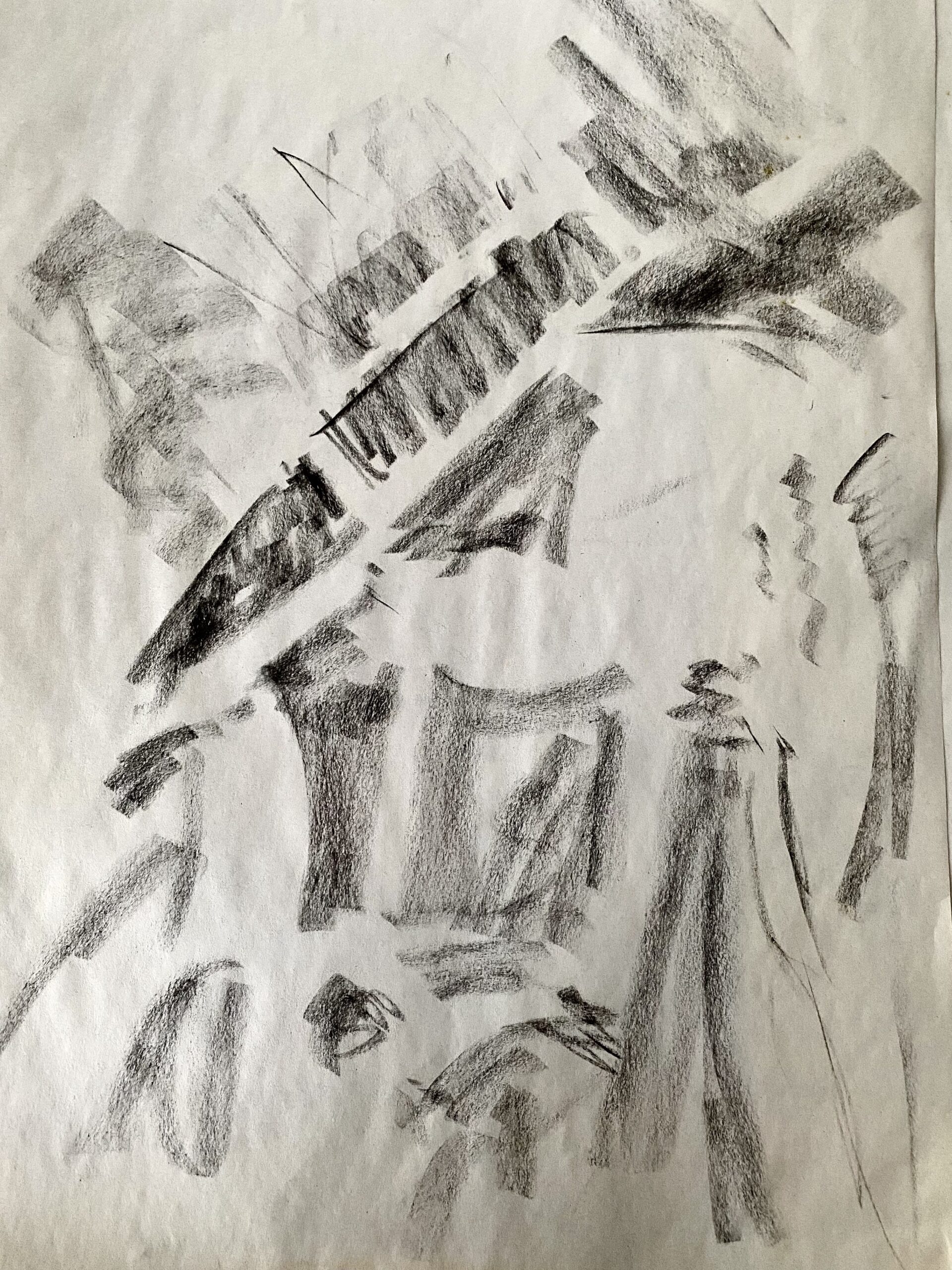
Drawing the Infinite: Using creativity to bridge challenging concepts and contemporary contexts

I remember sitting beside a piece of blank newsprint, clutching a twig of willow charcoal, looking at a table covered in all sorts of objects—a shiny chrome blender base, a bleached cow’s skull, yards of loosely draped fabric, old pieces of driftwood, a single ice skate and various pots, pans, and kitchen bowls. We were doing “gesture drawing” and my task was to use my charcoal quickly and loosely to sketch the vaguest and most general shapes I was seeing. I had to look beyond the detail of the objects to the ways in which overall shapes emerged from the play of dark and light. My attempts looked ghostly and out of focus, primitive and unskilled. The truth was that I had never done this before, and I felt completely out of my depth.
I was taking a drawing class in our Fine Arts department. This was my first undergraduate class in more than twenty years, and I was taking it for credit. I registered as a student at my own institution, going through a registration process where I was even asked to produce my high school transcripts. And here I was, sitting around the table with my charcoal twig and my newsprint along with the other students in the class, completely out of my comfort zone, remembering what it was like to be learning as an undergrad. I decided to take this course because I was becoming increasingly interested in the creative process and the ways in which creative expression could function to connect students with complex ideas and abstract notions. But in exploring this creative entry point, I also wanted to remember what it was like to be coming at these issues as a student and to be learning about things that required one stepping beyond one’s usual range of experience and expertise. A drawing class was something I hoped would improve my drawing, but also allow me to consider with more empathy the experience of students in my classes who encounter challenging ideas and practices all the time.
I learned a lot in this drawing class. I learned the difference between drawing what you see and drawing what you think. I learned that the creative process is often about following one’s nose, taking cues from what is in front of you and then taking the next step. I learned that inspiration often happens in hindsight, arising from consistent and sometimes less than inspiring routines. And I was reminded that learning involves taking risks and being vulnerable, ideally with the support of others around you.
In my own classes, I include a lot of creative expressions of religious ideas and beliefs from the history of art and literature. I have always found these examples invaluable as ways of further illuminating what can otherwise seem counterintuitive and elusive notions. Sometimes, even for the cultural Christian, notions of incarnation, sacred mystery, and ineffability, for example, can appear both overly familiar and bewilderingly abstract. Creative expressions from the tradition can serve to span the distance between ancient, paradoxical notions and provide a location for ideas to play out in connection with more familiar, contemporary experiences. And yet, even the greatest work of art, the greatest masters of Western culture, from the past and present, can sometimes fail to bridge the gap. Sometimes connecting what is counter-intuitive to what is creative means taking a risk. It means being out of one’s depth and feeling one’s way forward, exploring the link between mystery and possibility.
My attempts at gesture drawing were disconcerting, for sure, but in the end, they proved to be quite liberating. I had to let go of my preconceptions of what constituted “good art,” to quiet my internal art critic and trust my eye and my arm to do the work. I was forced to draw what I saw rather than draw what I had in mind. Stepping out of my comfort zone meant discovering new ways of seeing and new ways of doing. I could see that taking creative risks had the potential to open richer veins of insight and to reveal the invisible limitations of convention and culture that can sometimes limit inquiry and stifle growth. But does this exercise work in the other direction? Drawing what one sees rather than what one thinks is one thing, but what about the reverse? What happens when we draw what we have in mind and turn this idea into something others can see?
A simple exercise I have used to connect the abstract with the creative involves asking students to draw the concept of belief. I ask them to draw something that doesn’t easily translate to a discrete object in the world. In effect, I’m asking the students the impossible task of giving a complex, abstract idea discrete and specific form. Everyone knows what belief is, but what does it look like? While the results can be clever and are often surprising, they also reveal how obscure and unfamiliar the term was from the beginning. Drawing an abstract concept involves being creative, for sure, but it also means committing to something specific, making choices about what to put on the page versus what to leave out or unaddressed. Every picture is but a gesture of the totality. While, a single picture is always a limited account of a larger idea, when the resulting pictures from the class are gathered, a wonderful richness emerges, still fuzzy around the edges, still indistinct and relatively unformed and yet collectively, they are evocative, rich, and real. In this way, drawing involves embodying an idea, giving it a certain kind of flesh and form in ways that depart from the goals and achievements of writing alone. It is not that a picture tells a thousand words so much as pictures and creative expressions have the capacity to speak differently. The vividness of this creative act, the grappling with impossibility and the inspiration of a collective perspective prompts a learning journey that I view with renewed respect as deeply creative, slightly unnerving, and open to immense possibility.
Leave a Reply